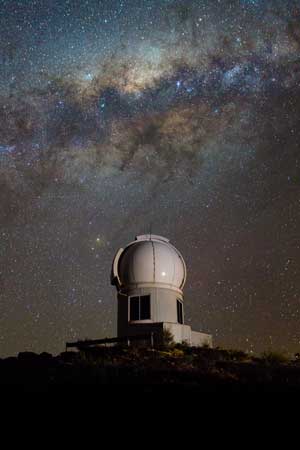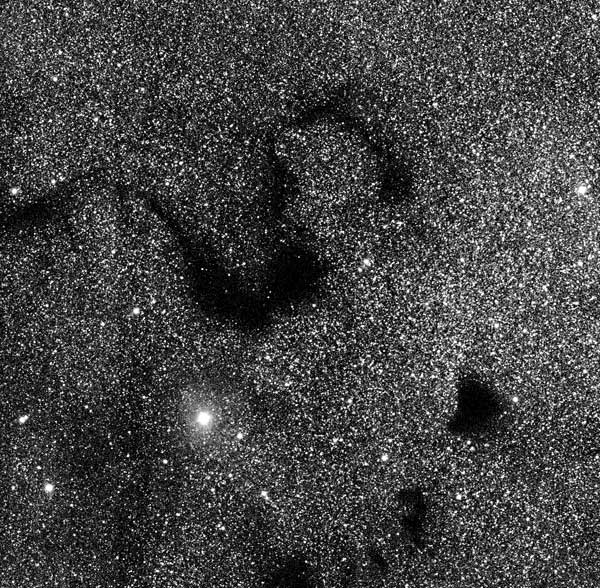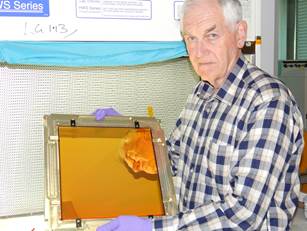A new telescope called the SkyMapper has charted stars and galaxies across the southern sky, producing a map called "the best ever created."

James Gilbert
Much as a mariner needs a reliable chart, astronomers depend on maps of the sky. As an observer in the 1980s and 1990s, before the digital revolution, my observing guides were the Sky Atlas 2000.0 and then the Uranometria 2000.0 star charts. These tomes guided me to celestial splendors, helped me identify transient objects, and unveiled clues as to the presence and nature of structures in the universe.
Today, astronomers rely less on the “how to get there” (telescope pointing has long been computerized) and more on the “what is there” and the nature of those objects. In recent years, the northern sky has been well-served by the Sloan Digital Sky Survey. Now, the Southern Hemisphere has its most extensive digital map yet — the SkyMapper Southern Survey.
Following the fires that burnt the Great Melbourne Telescope at Mount Stromlo, near Canberra, in 2003, the Australian National University (ANU) chose to build a new telescope, SkyMapper, at Siding Spring Observatory in northern New South Wales. SkyMapper is an automated 1.35-metre f/4.8 telescope with a wide, 5.7-square-degree field of view and a large 32-CCD-chip camera with 268 million pixels and six filters.
Astronomers are conducting the survey in two parts. The Shallow Survey, making up the bulk of this initial release, goes down to around 18th magnitude. It was designed to take short exposures so that the whole southern sky could be covered early in the project. More than 98% of the southern sky has been included in this first release, from the south celestial pole to +2o declination. The Main Survey, expected to be finished in 2020, will go a further 4 magnitudes deeper, mapping objects about 40 times fainter than in the Shallow Survey. By the end of the survey, SkyMapper will have recorded around 1 petabyte of data — enough to fill 223,000 DVDs.
The online map is accessible through an online portal that allows anyone to search for objects either by coordinates (right ascension and declination), catalog number, or popular names, such as “Jewel Box” or “Tarantula Nebula.” The portal also enables you to filter the view by each of the six wavelength bands measured by SkyMapper. For any given region, you can compare the view to those recorded by the historic Digitized Sky Survey or other observatories recording X-rays and infrared and ultraviolet wavelengths.
In announcing the data release, lead researcher Christian Wolf (ANU) said, “The map of the southern sky we’ve released to the world today is the best ever created.”

RSAA / SkyMapper, composed from Data Release 1
First Stars, Dwarf Galaxies, Old Quasars, and More

Gabe Bloxham
The survey has already delivered early results, including observations of the neutron-star merger GW170817 and the discovery of one of the oldest stars known. The 15th magnitude star SMSS J0313-6708, 6,000 light-years from us, is believed to have formed only 100 million years after the Big Bang. Searching for the first stars is one of the science goals of the SkyMapper survey, and the team notes that the Shallow Survey release is well suited to this goal, as high-resolution spectroscopic follow-up with large telescopes of candidate stars fainter than 16th magnitude can be expensive.
Other science goals include discovering dwarf galaxies and galactic remnants orbiting our Milky Way, unearthing new Kuiper Belt Objects in the outer solar system, and revealing the oldest quasars. During times when the seeing is poor, the SkyMapper telescope is used primarily for the SkyMapper Transient Survey, looking for supernovae and other changing phenomena.
Other complimentary surveys are in the pipeline elsewhere. It was announced last month that the Sloan Digital Sky Survey would expand to the southern hemisphere (a project dubbed SDSS-V), with operations beginning in 2020. It’s a spectroscopic survey rather than an imaging survey like SkyMapper. Indeed, Chris Onken (ANU) says, “I expect SkyMapper will be heavily used to help select sources for SDSS-V observation”.
Towards the end of next decade, when the 8.4-meter Large Synoptic Survey Telescope (LSST), currently under construction in Chile, has delved much deeper into the southern sky, its images will be saturated for objects around 16th magnitude and brighter (and therefore unmeasurable), so the SkyMapper’s digital survey will remain an important treasure map for astronomers for many years to come.
 2
2
Comments
December 22, 2017 at 5:44 pm
'its images will be saturated for objects around 16th magnitude'... that's pretty impressive!
You must be logged in to post a comment.
Graham-Wolf
December 28, 2017 at 8:52 pm
Hi Greg
Great work here.
Still emotionally recovering from the Mt Stromlo bush-fire massacre of many of Aussie's finest scopes.
Yep... it was a long 15 years ago, but the wounds still cut very deep.
Skymapper helps restore the old prestige to the site... at last.
Several of us ex Carter National Observatory astronomers had actually used the Bok 1.8m "Grubbie" (although not me, personally).
And the 9 inch Oddie, was strikingly similar to our own ex UK Cooke Refractor.
My best wishes,
Graham W. Wolf
46 South, Dunedin, NZ
You must be logged in to post a comment.
You must be logged in to post a comment.